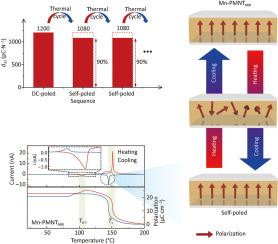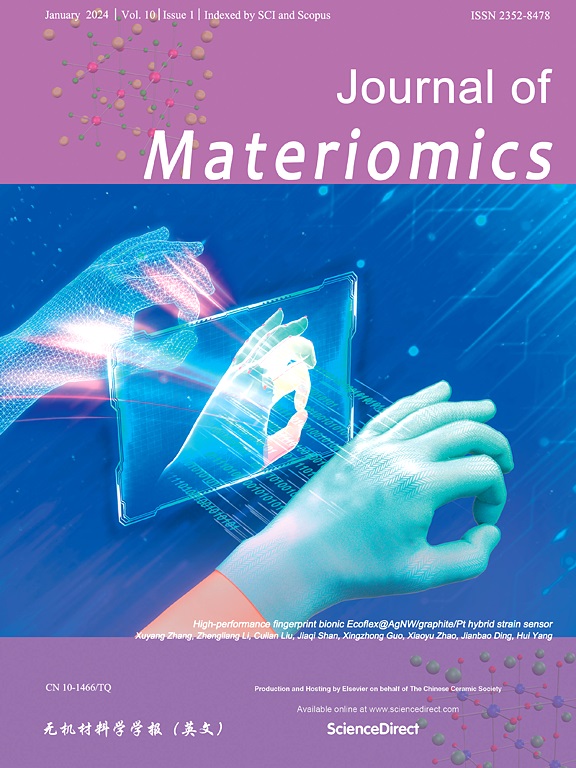Poling-free relaxor-PbTiO3 single crystals
IF 9.6
1区 材料科学
Q1 CHEMISTRY, PHYSICAL
引用次数: 0
Abstract
Relaxor-PbTiO3 ferroelectric single crystals have drawn attention aiming at high-end piezoelectric applications thanks to their excellent piezoelectric properties. Like all the other ferroelectrics, relaxor-PbTiO3 single crystals can only be piezoelectrically active upon being electrically poled. However, this poled state is thermally unstable, limiting their uses because of their relatively low depolarization temperature. Here, we show that a non-destructible permanent poled state can be realized in relaxor-PbTiO3 single crystals by forming a 0–3 composite in the presence of charged mobile point defects. We demonstrate this on solid-state grown 0.71 Pb(Mg1/3Nb2/3)O3-0.29PbTiO3 single crystals doped with Mn (Mn-PMNT) as a donor with well-aligned and dispersed boron-rich MgO-based inclusions (MBIs). Mn-PMNTMBI sharing [001] axis with arrayed MBIs were spontaneously polarized during cooling across the Curie temperature without an external electric field. The piezoelectric coefficient and dielectric permittivity of self-poled Mn-PMNTMBI crystals were as large as 90% of that achieved by a direct-current poling treatment at room temperature, and such poled state was reproducible against repeated thermal cycles. We expect that the poling-free high-performance piezoelectric relaxor-PbTiO3 single crystals offer an avenue for piezoelectric-based devices by removing the working temperature limit as one of the inherent fundamental limitations.

无极性弛豫器-氧化铋钛单晶体
弛豫器-PbTiO3 铁电单晶凭借其优异的压电特性,在高端压电应用领域备受关注。与所有其他铁电体一样,弛豫器-PbTiO3 单晶只有在电极化后才能具有压电活性。然而,这种极化状态热不稳定,由于去极化温度相对较低,限制了其用途。在这里,我们展示了通过在带电移动点缺陷的情况下形成 0-3 复合材料,可以在弛豫器-PbTiO3 单晶中实现不可破坏的永久极化态。我们在固态生长的 0.71 Pb(Mg1/3Nb2/3)O3-0.29PbTiO3 单晶上证明了这一点,该单晶以掺杂锰(Mn-PMNT)的锰为施主,具有排列整齐且分散的富硼氧化镁基包裹体(MBI)。Mn-PMNTMBI 与阵列 MBI 共享 [001] 轴,在无外部电场的情况下冷却至居里温度时自发极化。自极化 Mn-PMNTMBI 晶体的压电系数和介电介电常数高达室温下直流极化处理的 90%,而且这种极化状态可在重复热循环中再现。我们希望无极化高性能压电弛豫器-PbTiO3 单晶能消除工作温度限制这一固有的基本限制,为基于压电的器件提供一条途径。
本文章由计算机程序翻译,如有差异,请以英文原文为准。
求助全文
约1分钟内获得全文
求助全文
来源期刊

Journal of Materiomics
Materials Science-Metals and Alloys
CiteScore
14.30
自引率
6.40%
发文量
331
审稿时长
37 days
期刊介绍:
The Journal of Materiomics is a peer-reviewed open-access journal that aims to serve as a forum for the continuous dissemination of research within the field of materials science. It particularly emphasizes systematic studies on the relationships between composition, processing, structure, property, and performance of advanced materials. The journal is supported by the Chinese Ceramic Society and is indexed in SCIE and Scopus. It is commonly referred to as J Materiomics.
 求助内容:
求助内容: 应助结果提醒方式:
应助结果提醒方式:


